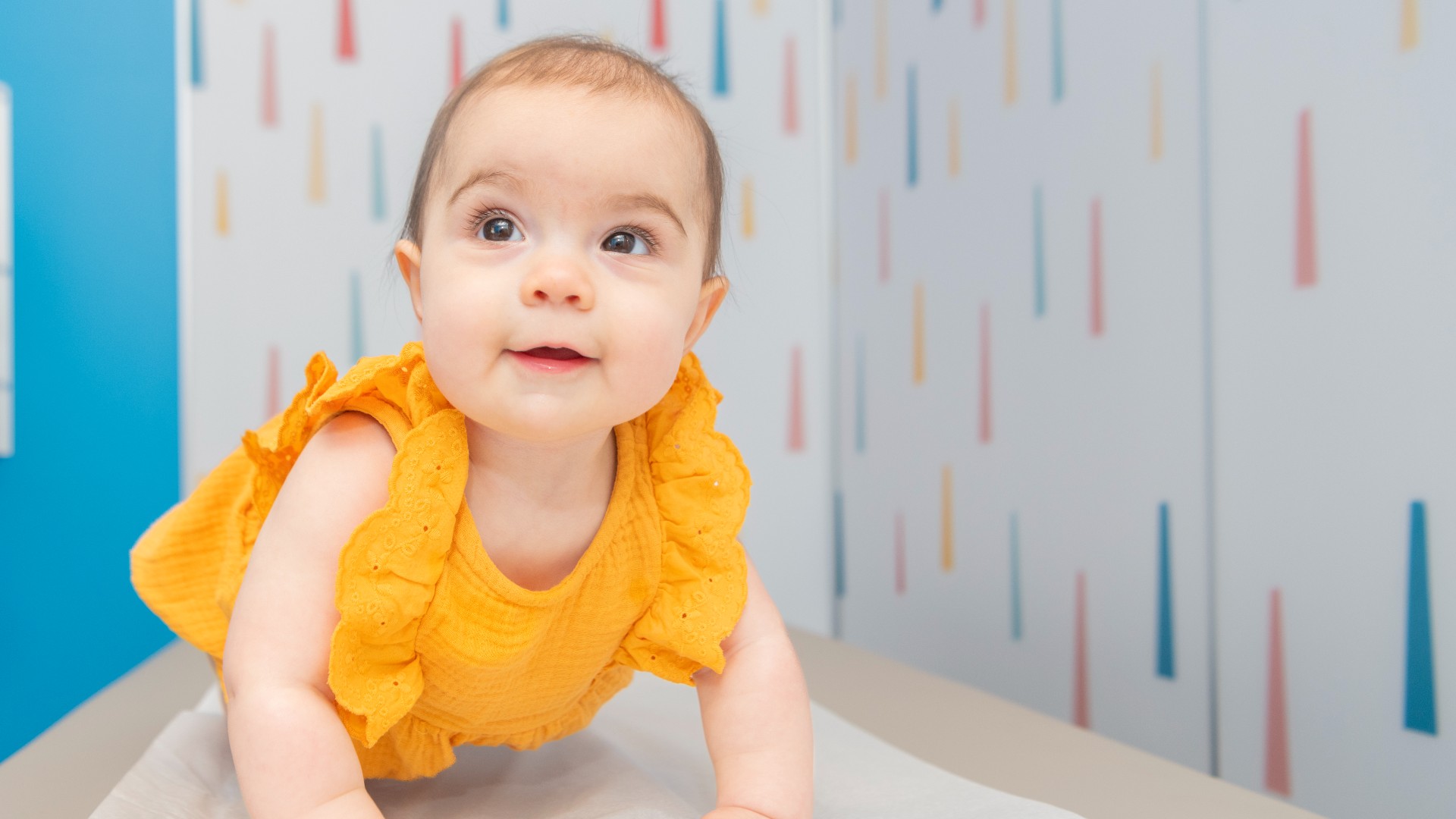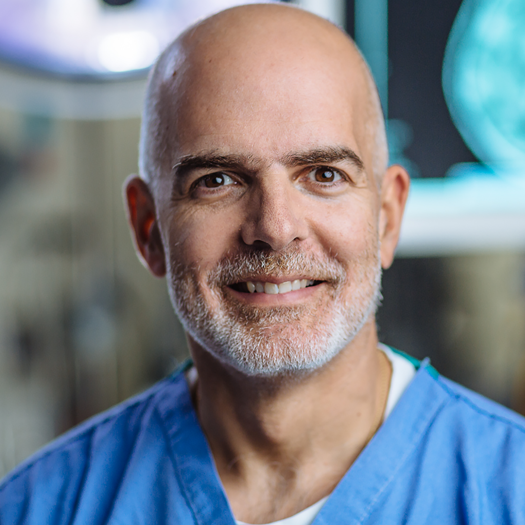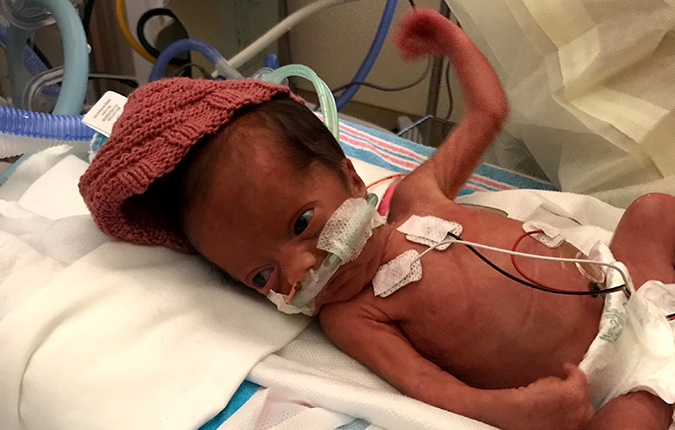Condition
Pediatric Craniosynostosis
What is Craniosynostosis?
Craniosynostosis is a condition in which the bones in an infant’s skull grow together too early, causing problems with brain growth and head shape. The edges of the skull bones are called sutures, which normally close by age 2 to 3. With craniosynostosis, the head stops growing in the areas where the sutures have fused, and expands abnormally in other areas.
Craniosynostosis can occur by itself or as a part of certain craniofacial (head and facial) syndromes. If left untreated, craniosynostosis can lead to serious complications, including:
- Head deformity, possibly severe and permanent
- Increased pressure on the brain
- Seizures
- Developmental delay
Frequently Asked Questions
What causes craniosynostosis?
Craniosynostosis usually occurs randomly for unknown reasons. However, some types can be associated with genetic disorders such as:
- Crouzon syndrome: Premature fusion of both coronal (ear-to-ear) sutures
- Carpenter syndrome: Premature fusion of sagittal (top of head, front to back) and both coronal (ear-to-ear) sutures, also abnormal growth of fingers and toes
- Saethre-Chotzen syndrome: Premature fusion of both coronal (ear-to-ear) and lambdoid (back of head) sutures
- Pfeiffer syndrome: Premature fusion of sagittal (top of head, front to back), coronal (ear-to-ear), and sagittal (top of head, front to back) sutures
What are the types of craniosynostosis?
There are several different types of craniosynostosis, and the three main categories are:
Scaphocephaly
- Most common type
- Closing of the suture that runs down the middle of the top of the head
- Long, narrow head growth, often causing a broad forehead
- More common in boys than girls
Plagiocephaly
- Next most common type
- Closing of a suture that runs from the top of the head toward either ear
- Uneven brow and forehead growth on one side
- More common in girls than boys
- Read more about plagiocephaly.
Trigonocephaly
- Rare type
- Closing of the suture that runs from the top of the head through the forehead
- Pointed forehead growth, from mild to severe
- More common in boys than girls
What are the symptoms of craniosynostosis?
The most noticeable symptom your baby may have is an abnormally shaped head or face. Other symptoms in newborns, infants and young children happen because of increased pressure inside the skull, including:
- Missing, full, or bulging "soft spot" (fontanel) on the newborn's skull
- Bony ridges along the affected sutures
- Facial abnormalities including flattened forehead and brow on one side, pointed forehead or close-set eyes
- Prominent blood vessels in the scalp
- Poor feeding or projectile vomiting
- Bulging eyes
- Seizures
How is craniosynostosis diagnosed?
Often, your pediatrician can diagnose craniosynostosis by examining and measuring your baby’s skull. Further tests to confirm a diagnosis and check for related disorders include:
- X-rays to check for fused (missing) sutures or ridges along sutures
- Diagnostic imaging, especially CT scans, also to check for fused sutures or ridges along sutures
- Genetic tests to check for syndromes that cause craniosynostosis
What are the treatments for craniosynostosis?
Treatment goals focus on relieving pressure inside the head, ensuring enough room for the brain to grow and correcting skull and facial deformities. At Children’s National, we may recommend one or more of the following treatment options:
- Surgery before age 1, while the skull bones are relatively soft
- Minimally invasive surgery for infants younger than 3 months to open skull sutures for normal skull and brain growth
- Traditional surgery for infants 6 months or older to correct the skull’s shape
- Cranial (skull) molding using helmets to reshape the skull
Specific treatment for craniosynostosis will be determined by your child's doctor based on:
- Your child's age, overall health, and medical history
- Extent of the craniosynostosis
- Type of craniosynostosis (which sutures are involved)
- Your child's tolerance for specific medications, procedures, or therapies
- Expectations for the course of the craniosynostosis
- Your opinion or preference
Surgery is typically the recommended treatment. The goal of treatment is to reduce the pressure in the head and correct the deformities of the face and skull bones. Less commonly, surgery is needed to decrease pressure within the skull.
The optimal time to perform surgery is before the child is 1 year of age since the bones are still very soft, have not fused at other sutures, and are easy to work with. Surgery may be necessary at a much earlier age depending on the severity of the condition. Because blood loss can be an issue in this type of surgery, surgery is often delayed in the very young child to allow some growth and development and a greater blood volume. Most procedures are done between 3 and 8 months of age.
Before surgery, your child's doctor will explain the operation and may review "before and after" photographs of children who may have had a similar type of surgery.
Following the operation, it is common for the child to have a turban-like dressing around his or her head. The face and eyelids may be swollen after this type of surgery. The child is typically transferred to the intensive care unit (ICU) after the operation for close monitoring.
Problems after surgery may occur suddenly or over a period of time. The child may experience any or all of the following complications:
- Fever (greater than 101 degrees F)
- Vomiting
- Headache
- Irritability
- Redness and swelling along the incision areas
- Decreased alertness
- Fatigue
These complications require prompt evaluation by your child's surgeon. The healthcare team educates the family after surgery on how to best care for their child at home, and outlines specific problems that require immediate medical attention.
What are the life-long considerations for children with craniosynostosis?
The key to treating craniosynostosis is early detection and treatment. Some forms of craniosynostosis can affect the brain and development of a child. The degree of the problems is dependent on the severity of the craniosynostosis, the number of sutures that are fused, and the presence of brain or other organ system problems that could affect the child.
Genetic counseling may be recommended by the doctor to evaluate the parents of the child for any hereditary disorders that may tend to run in families.
A child with craniosynostosis requires frequent medical evaluations to ensure that the skull, facial bones and brain are developing normally. The medical team works with the child's family to provide education and guidance to improve the health and well-being of the child.
Providers Who Treat Craniosynostosis
Robert Francis Keating, MD
Locations
Departments
John Socrates Myseros, MD
Locations
Departments

Albert K Oh, MD
- Director, Cleft and Craniofacial Program
- Director, Plastic Surgery Fellowship
- Plastic and Reconstructive Surgeon
Hasan Raza Syed, MD
Locations
Departments
Jul 22, 2024
Helping Maddie to Live Life to the FullestMaddie is a lively, creative teen who loves to act. Research at Children's National Hospital helps to ensure that her rare disease doesn"t upstage her big theater plans or her love of life.
Jun 27, 2024
Convenient Care for CharlotteWhen Charlotte was a toddler, a respiratory illness led to a diagnosis of a rare and dangerous immune deficiency called ICF syndrome. A bone marrow transplant at age 5 at Children’s National helped save her life.
May 20, 2024
Omid Conquers Fear with MusicOmid never liked going to the dentist. Dr. Aleger changed that with a little trust, and his favorite tunes.
Departments that Treat Craniosynostosis

Rare Disease Institute
Children’s National Rare Disease Institute (CNRDI) is a first-of-its-kind center focused exclusively on advancing the care and treatment of children and adults with rare genetic diseases.

Neurosurgery
Our neurosurgery experts provide advanced care for newborns and children with complex neurological conditions.

Plastic and Reconstructive Surgery
Our team of pediatric plastic surgeons have dedicated their careers to plastic surgery procedures for babies, children and teens.

Cleft and Craniofacial Program
The Cleft and Craniofacial Program at Children’s National brings together experts from 10 pediatric disciplines to provide complete care for children with craniofacial disorders. Our multidisciplinary pediatric team helps more than 400 children every year.










